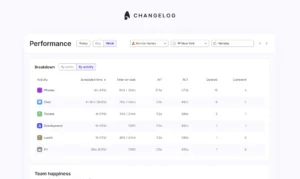
The Importance of Team Planning in Customer Support

Customer support teams are the face of a company and play a crucial role in building and maintaining healthy customer relationships. A well-functioning support team can be the difference between a happy customer who will remain loyal, and one who will take their business elsewhere.
That’s why it’s so important to invest time in team planning and to ensure that teams have the tools, resources, and processes they need to provide top-notch support.
Below, we have outlined a step-by-step guideline for team planning.
Define Objectives and Goals
The first step in team planning is to define clear objectives and goals. Determine what the team needs to achieve, and set holistic metrics to measure their success.
For customer support teams, objectives include improving response times, increasing customer satisfaction, lowering customer effort score (how much work a customer has to put in to get their issue resolved), improving NPS (net promotor score), and reducing the number of repeat customer inquiries.
All of these metrics come in to account when planning your support teams intraday activities, and how work is divided across the team.
There aren’t just inbound channels to think about, but also operational tasks such as refunds, delivery follow ups, bill fixes and speaking to third parties involved in a transaction. And you want to make sure there is time carved out for personal projects, training and meetings.
Account for different timezones and shift preferences
Once objectives and goals have been established, it’s important to understand the working preferences of your customer support team. Some surfers (what we call support agents) like to work in the mornings, and others in the afternoon.
In the case of timezones, half of your team might be in London, while the other half is in Auckland. Planning your team in a way that accounts for different timezones, shift patterns, and working styles is imperative and also challenging to do without proper tooling.
Choosing the right tooling
Customer support teams need proper tooling to do their job effectively. This includes access to technology, such as customer relationship management (CRM) software, telephony and chat systems and internal communication tools like Slack. It’s important to choose tooling in a way that supports the team’s objectives and goals, and benefits your team as individuals.
Software and other tooling can really impact the way a support team works and its culture, so it’s important to decide upfront what type of support team you want to be leading and pick your tooling accordingly.
Beyond technological resources, your team needs to be trusted, empowered, and given autonomy. This can be done through setting the right targets, monitoring performance and avoiding excessive micromanagement through time tracking. You should be course correcting where it’s clear targets aren’t being hit, but not making your valued team members feel like they lack agency.
Develop Standard Operating Procedures
Standard operating procedures (SOPs) provide a framework for how customer support teams should handle common customer inquiries and support requests. SOPs should be detailed, easy to follow, and regularly updated to reflect changes in customer needs and support processes.
Once a process has become standardised and repeatable, automation is the next step. Tools like Intercom help with automating common issues. This allows teams to spend their time solving complex problems, rather than spending time on menial tasks and grunt work.
Create a Schedule
A well-structured schedule helps customer support teams manage their workload and ensure that customers have great experiences when interacting with your brand.
Support teams often try to make spreadsheets work as a temporary fix when they’re small. However, as a company and its customer base grows, the support function comes under more pressure, requiring a tool that better orchestrates all the moving parts within the organisation.
Using spreadsheets to schedule a growing support team is like paving over the cracks of a leaky dam. It’s a temporary solution, and if it’s not fixed at a foundational level, the dam will eventually burst. Customer support team scheduling software like Surfboard empowers support leaders to build customised shift plans unique to their teams needs that scales with them as they grow, rather than breaking once they reach 10 support agents.
“I genuinely believe Surfboard is game-changing and ultimately a must-have for start-ups once they drift into 15+ seats.” (read the full success story here)
Luke Bishop, Head of CX, Katkin
Monitor Performance
Regular monitoring of team performance is important to identify areas for improvement and to make any necessary adjustments. This includes tracking metrics, such as response times and customer satisfaction, as well as conducting regular team performance reviews.
One of the major benefits of using scheduling software is that it allows support leaders to avoid doing tedious planning tasks, so they can spend time developing and training their team instead.
Foster Collaboration
Collaboration is a key element of team planning within customer support teams. Planning and scheduling any team should be done in a collaborative manner, so that everyone involved knows their role, what they should be working on, and has a say in the scheduling and planning of shifts.
Teams have different preferences on when they work and how they work. Collaboration devolves sole responsibility of scheduling from the manager to the team, allowing preferences to taken into account.
The best collaborative tools remove friction through commenting and tagging. This is a much better approach to organising when people work and course correcting when things change, such as phone calls taking longer than expected. At Surfboard, we believe collaboration is a better way of managing teams than intrusive surveillance, but achieves the same outcome.
The value of team planning in customer support
Team planning is essential for customer support teams to provide top-notch support and to exceed customer expectations.
By defining objectives and goals, choosing the right tooling, developing standard operating principles, creating a robust schedule, monitoring performance, and fostering collaboration, customer support teams can deliver outstanding support to customers.
Investing in team planning and development increases team morale, reduces turnover, and ultimately make teams and customers happier.
If you’d like to find out why Surfboard is the best option for customer support team planning, leave some details below and we’ll be in touch to show you how.



